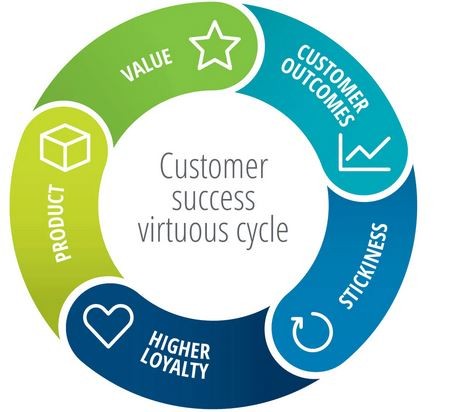
How can organizations keep their focus on their customers rather than the technology offered at the center of Digital transformation efforts?
This article explores the benefits of developing a pro-active customer success model that leads into a fruitful bilateral relationship with our partners.
The Customer Success Mindset
Have you ever heard of the Customer Success Virtuous Cycle? It’s a driving factor of how we orchestrate the customer journey that maximizes the value for the end customer across the entire life cycle. Our main focus is to activate this Virtuous Cycle at the beginning of any engagement.

Reference: Deloitte Analysis | deloitte.com/Insights
I personally believe that organizations must make all their customers or clients central to the Digital Transformation effort, but how do we benefit from this? Let me explain.
B2B Companies that invest in a CS Function, are looking for a variety of gains.including lower cost to serve, higher willingness to spend, increased loyalty, and brand advocacy. Unsurprisingly, good customer success capability execution brings tangible benefits:
Customer Spending: is influenced directly when clients start experiencing good customer service and service providers start taking accountability for the services or products offered to a partner.
Customer Tenure: After building a relationship; on-boarded customer expenditure grows alongside trust. Eventually loyal customers spend more than new ones.
Organizational Cost of Service: Maximizing satisfaction in turn leads the cost and internal effort of serving our partners lower by at least 20%
Referrals: After positive experiences, Most of your customers would be happy to provide a referral if asked.
While all these factors are wonderful benefits that we all strive to acquire one must strategize in building the Client-Centric Mindset within the organization.
Getting Started: Focus on Producing Outcomes
Service Providers always fall into a trap of, how do i maximize value for customers from my offerings? Should i offer a new portfolio of products and services outside of what i have or Should i offer man-power? How about offering discounts and deals?
Identify The Value Add
To start focus on the outcomes we should always ask ourselves how we as representatives of the business we own or are employed at, add-value to our customers outside the products and services, that are so blatantly pushed down their throats through our Sales Teams.
To understand this, we must first get into the psychology of a client who is availing a product or service. Client’s are paying for products and services to avoid discomforts or inconveniences in their day to day business as usual’s, and if these inconveniences continue in the midst of your transactional agreements, this means that you or your Company haven’t added Value to your partners at all.
While technology cannot necessarily fix all these discomforts, we have to accept and realize the truth that that there will always be issues & concerns regarding your offerings because there are no one-size fits all type of product solutions.
In turn companies with Mature Customer Success functions, understand that its all about problem solving and accountability for any inconveniences incurred by the services offered as the representative of your company, and the most important being the voice of your customers internally within your organization.
Pushing for additional products and services blatantly to customers with no regard to the current situation down their throats, alienate and build negative connotations about you and the companies value to a customer as it gives an impression that your just there to sell. Focus by solving problems, getting things done and most importantly being trusted.
Focus on the Customer Outcome:
The Biggest problem most Technology service providers have is they don’t practice internal and client based governance of the products and services offered.
Whenever your working with a client, always have their best interests in mind, and to do this your Customer Service Function must set-up either a recurring monthly check-in and a quarterly business review with them where they can voice out their concerns in a official platform regarding your products and services and plans for the future.
Conducting these Governance meetings, gathering information and acting upon them allows your organization to identify new opportunities and or areas to to tackle or improve upon when dealing with new or existing customers.
This is a strategy to not allow the similar mistakes occur with other clients and keep a record of documentation of lessons learned which you can avoid making.
Transparency is key, not only are these meetings in nature measures to help your customers address their issues and or concerns but is also an opportunity to talk about both your business plans and expectations in the near future.
The most successful customer success teams, are always in communication with the client as a partner representative and is also the key voice in getting internal operations teams moving to address issues or concerns and gives relevant value to your leadership’s response. When demanded by a partner.
Relationships between key client and vendor personnel and executives make a difference in how a client account is handled, and these relationships must be fostered over time. Executives who have the authority to apply extra resources and make decisions for the account, and who have skin in the game for financial performance of the account, need to be intimately familiar with the client’s operation in order to properly react when problems occur. Familiarity with the client’s business, and the requirements of the contract, is achieved over time, often through consistent governance routines and meetings between the parties at all levels.
Users sometimes have different viewpoints on service quality versus internal management or a vendor. If internal management teams and the vendor agree on interpretation of service delivery successes and failures and share this common understanding across governance tiers on a regular basis, it is easier to respond in a streamlined way to user inquiries or complaints.
Both clients and vendors can maximize these vendor governance benefits when both parties consistently follow governance routines. Alternatively, resurrecting governance activities only after problems have materialized creates a defensive dynamic between client and vendor that inhibits this interaction.
Clients should make it a priority to maintain strong governance at all times–those efforts will inevitably pay dividends throughout the contract term
Applying Stickiness & Loyalty
Brand loyalty is as straightforward as employee retention. When a business fails to interest its customers, reward them, or help them grow, they will abandon it for someone else that fulfills these needs.
SaaS businesses employ various tactics to keep customers stick to their product, such as offering a certain percent off on yearly subscriptions or getting customers to cultivate enough data on the platform so that migrating to a competitor brand becomes somewhat of a hassle. It’s why they create lock-in periods or have customer success teams alongside support teams. They write blogs on relevant topics or invite industry experts to speak on webinars. They also create drip campaigns and send informative newsletters every month.
SaaS companies take all the effort to better engage with the customers and educate them because they want to help customers realize their goals. Eventually, the karmic cycle of the business cosmos rewards the SaaS vendors with new opportunities as their customers grow at scale and require more of their services.
A great way to make your customers stick to your brand is to KISS (Keep it Simple Stupid) your business standpoints and help your customers with decision simplicity.
Building stickiness into a brand is a tricky game, especially if your taking a client-centric approach which is why businesses like Gillette and Apple come up with subtle, pragmatic ways to make buyers stay with their products. But savvy marketers work on improving their brand’s offering to a create more intrinsic, more voluntary brand loyalty.
Here are a few tips on how you can create a strong brand stickiness into your product:
1. Be useful
Over 4 million businesses use G-Suite Apps for everyday communication and collaboration at work because their products are helpful and deliver great value. From Google Docs to Apps Script, G Suite apps are built to help business departments solve their everyday problems in the simplest way possible. Their cross-platform integration with a multitude of other apps makes them the most sought-after collaboration suite in the business world.
2. Be consistent
There are many reasons why fans love The Ellen DeGeneres Show; Ellen is funny, she’s caring of her audience and the world around her, and she’s been delivering value to her audience since 2003! That’s a long, long time before other American talk show hosts like Stephen Colbert or Jimmy Kimmel made their TV debuts. Her fans trust her to feed their muse regularly, which is why her YouTube channel has over 22,307,549 million fans – ranked as one of the subscribed channels in the platform.
3. Be there for customers
Being able to answer customer queries on time is of paramount importance for e-commerce businesses. And no other channel does it better than a live chat support platform where sales and support agents can assist buyers in real-time and/or through automation. Club Factory, an emerging direct-from-factory e-commerce business, uses freshchat for their mobile app to offer personalized customer experience, help visitors self-navigate to the right page, or to chat with a lead bot during offline business hours.
4. Create an emotional appeal
Many brands like Apple, Nike, and Harley-Davidson have a cult-like fan following across the world because their products become an important part of the customers’ lives. Consumers worship these brands and volunteer as the outspoken brand ambassadors for their products. It’s because Apple products evoke a sense of exclusivity among their users, Harley-Davidson makes their motorcyclists feel free and adventurous, and Nike instills a strong sense of grit and the desire to find their greatness in their buyers.
5. Keep things simple
One of the best ways to help customers stick to your brand is to KISS your business touchpoints and help customers with decision simplicity. Buyers don’t always care if the technical features in your product will make it last through the post-apocalyptic world. Most often than not, they just want to know if it will solve their problems. A simple way to test your brand’s simplicity is to run your brand communication through the Mom Test, a favorite approach among Silicon Valley tech elites to measure simplicity. The test suggests that you keep your communication simple enough for grandmothers and mothers to understand so as to not complicate their buying decision with information overload and feature creeps.
Forgeting the Product but Adopting Solutions
If your in the customer success industry, we understand that quotas have to be made, while its a reality we would like to overlook. The focus to offering a new shiny product to your customer should come as your last resort if your planning on building an environment of shared trust, accountability and responsibility.
Transforming your team’s approach to sales requires a shift from just pushing products to creating genuine connections with people. And those genuine connections don’t include fraud and mistrust.
Many companies have archaic systems and compensation strategies in place that drive sales teams to act in ways that aren’t in their customers’ best interest.
But sales don’t happen in a silo. All departments — from marketing to research and development to customer service — have to work with sales to create true value for customers. And that’s a message that has to be spread, because the way the world does business today is changing at a rapid pace, and buyer’s expectations are changing right along with it. In turn, ill-equipped companies tend to respond to these increased pressures by doubling down on old practices and hoping for the best.
But that old way of operating is not sustainable. To achieve the aggressive sales growth that many companies require, sales departments need to stop trying to sell products and start selling solutions.
The difference a solution can make
At first, the difference between selling a product and selling a solution may not be apparent — after all, aren’t most products created to solve problems?
But most products are designed as one-size-fits-all solutions. Rather than working to fit each individual customer needs, products are usually made to be “good enough” for the widest audience. Solutions, however, combine products and services. They’re designed to help the customer every step of the way, ensuring that each customer’s unique problems are solved by the journey’s end.
Selling a solution requires that companies fundamentally change how they do business: Instead of pushing products, they must create genuine connections with other people. The solution-selling methodology requires lasting relationships with clients in which the goal is always to find new ways to help.
Solution selling in action
I’ve experienced the benefits of this system firsthand, watching sales representatives help customers unearth and comprehend their most compelling problems. Switching to this methodology has forced my previous company to take steps to recognize and end the cross-functional dysfunction that previously went unnoticed.
Making the transition isn’t easy, but the alternative can be disastrous. Here are four steps that will help smooth out that transition, turning a company stuck in the past into one ready for the future.
1. Prepare and qualify.
Treat sales like customer service. This means anticipating customers’ needs and having a greater understanding of their issues and challenges than they do, themselves. To properly implement a solution-selling methodology, every member of the sales team needs specialized knowledge and expertise. Apple, for example, has trained its salespeople so successfully that many companies have chosen to copy its entire model
Make sure that every lead coming from marketing is properly qualified. That way, sales teams can do their due diligence and remain experts for every customer, while early-stage leads will remain with the marketing department until they’re truly sales-ready.
2. Offer the buyer new ideas and perspectives.
A pervasive myth in sales is that the more knowledgeable clients are, the more likely they are to shop around and find an alternative. In actuality, improving customer knowledge has the inverse effect, fostering trust in a company and its products.
By assuming a teaching role, the “solution representative” becomes a trusted partner in a collaborative process. I worked with sales rep’s who exemplifies this mantra, helping customers recognize their pain points, anticipating and responding to potential problems, and aiding the entire process of implementing our solution. This enables the rep to offer a new perspective — and can lead to more business from thankful customers.
3. Shatter archaic structures in every department.
The solution-selling methodology isn’t just for the sales team; it’s a prescription for the whole company. As such, any silos or archaic compensation strategies that impede solution selling should be rendered obsolete.
Leaders must be open to critically evaluating everything about their companies, including command structure and culture. This can be tough — especially if the company has enjoyed a good ride. But sometimes, even if a company’s culture isn’t broken, it still needs to be fixed in order for the company to move forward.
Fruitful solution-development relies on open communication and broad inquiries. If there’s evidence that the flow of information is being impeded, do whatever you need to in order to open those channels.
4. Create a sales liaison role.
Sales success hinges on marketing’s ability to generate enough qualified leads. For this to happen, marketing needs to be clear about the sales team’s needs, such as its communication preferences and demographics. The two departments should also engage in a free exchange of best practices.
A sales liaison — one who works within the marketing division but can relate to both — is an essential part of ensuring that this understanding occurs. This employee is the key to relaying the necessary sales information that will enable the marketing team to create initiatives that advance solution-selling goals.
Embracing a customer-focused ideology is more than just good PR. It’s the path forward for every company wishing to embrace today’s disruptive world. The modern customer is looking for tailor-made solutions, and it’s about time startups took that to heart.








